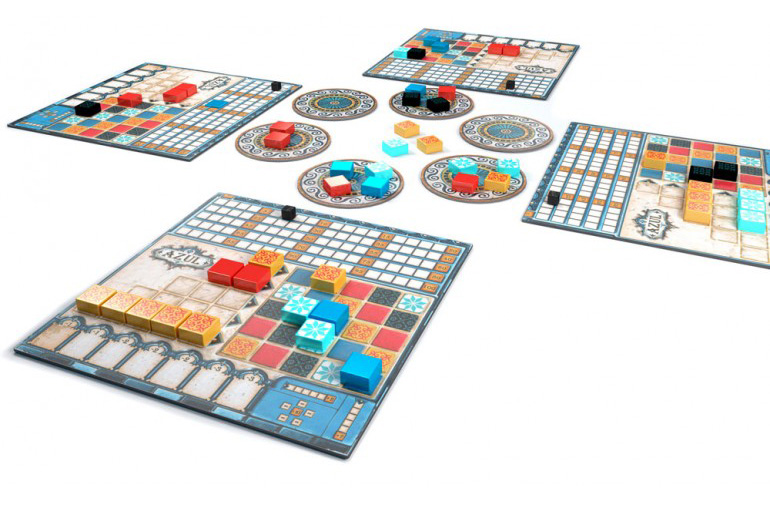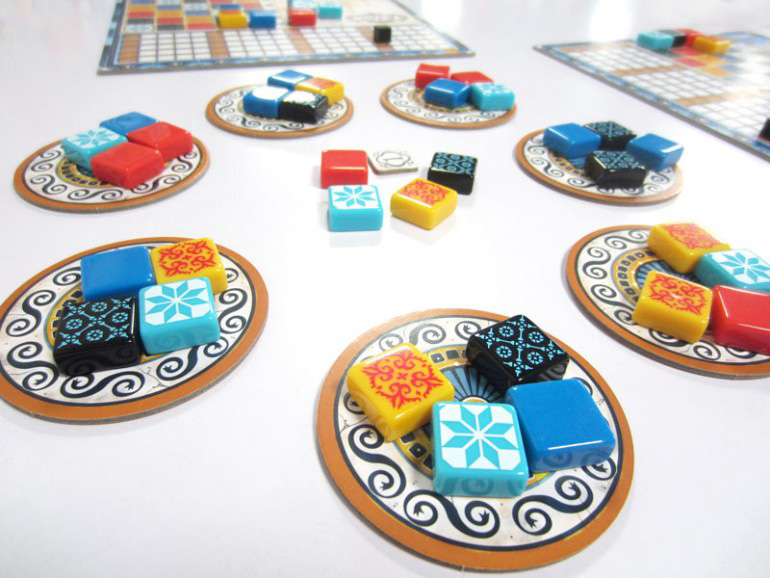Decorate the Palace with Ornate Tiles in Azul

Azul is an abstract game from Plan B Games, designed by Michael Kiesling, that received an incredible amount of buzz at Spiel 2017. But was this success justified?
The hype surrounding Azul since before it came out was very much reflected in the hordes of people playing the game at Plan B’s booth at Spiel. Although it was not the only game the company was releasing at the time, Azul easily overshadowed anything else.
What is this game all about?
Azul is based on a theme that, for an abstract game, makes perfect sense. Players take on the role of artisan tile makers in Portugal making azulejos, hence the name. Inspired by the tiles found in Alhambra – Granada, Spain – King Manuel I ordered his home, the Evora Palace, to be tiled in the same style. The Portuguese were so in love with the designs that a whole industry grew up around creating tiles and tiling walls.
And now it is your turn to find out if you have what it takes to be the best at tile laying.
But what sort of game is it?
In Azul, players take tiles from the center of the table and lay them on their player boards. Every round, when the tiles on the table have all been allocated, a number of tiles will be transferred to the wall and score points.
When a player manages to obtain a row of tiles with all the five colors, the game is over, the final scoring is calculated, and the player with most points wins the game.
The game takes about 30 to 40 minutes to play, depending on the number of players. I have played with three and four players and I felt there was little difference.
From a production point of view, the game is fantastic. Very well designed double–sided cardboard player boards serve as the placing areas for the tiles and the scoring. The tiles themselves are super lovely. You would be forgiven for looking at them like candies. They also look delicious.
But they don’t taste of anything. In fact, you could choke on them, so don’t put them in your mouth. Anyway…
A thin (if beautiful) cloth bag to hold the tiles, rules that are well laid out and explained, an insert that has been carefully thought out – even if the circular tiles don’t really stay in place if the game is in transit or stored vertically – a first player token, and some small black wooden cubes complete the components.

How does it play?
In the center of the table there will be some circular tiles representing the clay ovens. Each will hold four of the colored plastic tiles. The number of ovens will depend on the number of players.
On their turn, a player can take all tiles of the same color from an oven and move the remaining tiles to the center of the table. Alternatively, they can take all the tiles of the same color from the center of the table.
Those tiles will be placed on one of the five rows of tiles on the player board, the Factory Offer. The idea is to complete the rows, keeping in mind you can only place tiles of the same color on the row and that you can’t divide the number of tiles you take across more than one row. When all the tiles on the table have been moved to the player boards, the rows of tiles that have not been completed will be discarded. If they have been completed, one of those tiles will go on the wall and score points. The rest of the tiles on that row will be discarded.
The first player who takes the tiles from the center of the table becomes the next round’s first player. He also puts the first player token on the floor area of the player board. Going first on the round can be a pretty big advantage, though it does indeed come at a cost.
If you are forced to take more tiles than the number you require, then they fall on the floor and will subtract points. Which is very annoying.
Scoring is as easy as counting the tiles you place on the wall and the number of tiles adjacent on the same row and column. A well-placed tile can score you up to 10 points. Hard to do, though, and it would end the game as it would mean a completed row of different tiles.
Then subtract the points of the tiles you may have on the floor. Even though you can never score negative points, you can drop to zero points in one round…harsh!
One of the sides of the player board has a set pattern of tiles one has to follow. The other shows a grayed-out wall where people can place the tiles where they wish, as long as they follow the rules of not repeating tiles of the same color.
Although a seemingly trivial change, this is a pretty hardcore way of playing and truly makes the game a lot more challenging and cutthroat.

Review
Let’s not beat around the bush with this: Azul is fantastic.
Teaching the game can be done in a matter of minutes and it is simple enough that a child can learn it. Literally.
With great replayability value, Azul does very well on the table and offers quite a lot. Player interaction, although not the aim of the game, happens when other players take the tiles you need, or adds tiles to the color you need, making it necessary for you to take excess tiles and the penalty that comes with them. This is just as annoying when it happens to you as it is satisfying when you are the one propitiating the loss of points. Or maybe I find it satisfying to be evil. I don’t know.
With a theme that makes sense, though it is as thin as you could expect for an abstract game, Azul does look truly gorgeous on the table. Completing as many tiles as possible to see the wall being built is just another appeal of the game. Admittedly, it is one that fades once you have built that wall a few times, but it is there nonetheless.
Pros: language independent, great production value, easy to learn, very fun to play
Cons: penalties can be rather harsh







